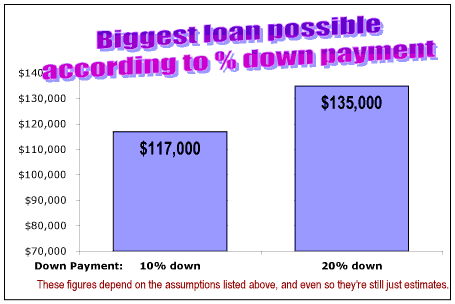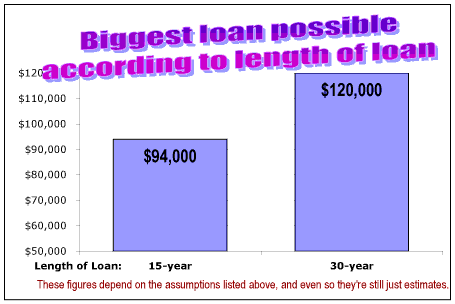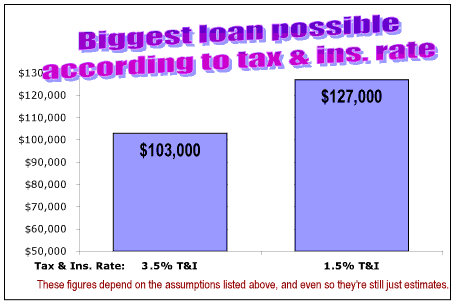This site is used as a homework reference in:
Stoughton High School (Pat Schneider's economics class)
|
|
|||||||||||||||||||||||||||||||||||||||||||||||||||||||||||||||||
Extra details about the topics: How much
home can I afford? and
|
||||||||||||||||||||||||||||||||||||||||||||||||||||||||||||||||||
| « Back: How much home can you afford? « |
Of course, if you haven't already gone through the basics of how much home you can afford and haven't used the calculator then you should go back there now before reading any further — the page you're on now is the advanced stuff.

Okay, on with the advanced stuff....
You'll remember the simple formula from the previous page — since you pay for your house with a combination of a down payment and a bank loan, the total of both is the cost of the home:
Down Payment + Biggest Loan You Can Get = How Much Home You Can Afford
You know how much you can afford for a down payment, so that part's easy. (At least you should know — if you don't then you should probably figure that out before going any further.) So that leaves us with finding the biggest loan we can get. So really, the rest of this page is really "How much loan can I get?" and not "How much home can I afford?" To find how much home you can afford, just add the amount of down payment money you have saved up to the amount you can get for a loan.
We've left one thing out of our simple equation above: closing costs. You'll need to either pay the closing costs from your savings (lowering the amount you have available for a down payment), or qualify for a loan that's a little larger than the house you want to buy, and have the closing costs added to the loan. But that's not important right now.
Returning our focus to getting the biggest loan possible, here are the things that can get us a bigger loan:
- Higher monthly income
- Lower existing monthly debt payments
- Bigger down payment
- 30-year mortgage (vs. 15)
- A better credit score
- A lower property tax & insurance rate
Let's look at each of these in detail.
Higher Monthly Income.
Obviously
the more you can afford to pay for a home, the bigger the
loan you can get. The bank limits your monthly mortgage
payment
(including taxes and insurance) to no more than 28 to 36% of
your
monthly income. What determines where you fall on that
scale is the
size of your down payment and your credit score. In any
event, the
higher monthly payment the bank allow s,
the bigger the loan they'll
give you.
s,
the bigger the loan they'll
give you.
This 28 to 36% figure is called the Housing Ratio. For example, if you make $3000/mo. and the bank uses a housing ratio of 33% then the bank figures you can afford $990/mo. in mortgage payments ($3000 x 28%). (They also limit how much you can borrow based on how much debt you have, but we'll cover that later.)
Usually there's not much you can do in the short-term about your income, but in one case there is: Buy a duplex or a house with a separate garage apartment that you can rent out. Then you can count the amount you'll collect in rent towards your income. Some lenders are finicky about counting the rental income, but you can almost certainly find one who will. Your chances improve if the space is already rented and the renter has a long-term lease. Being able to count this extra rental income can help you buy a more expensive home—which will be a much better investment.
The chart shows how having a higher income means a bigger potential loan amount. These are estimates of loan amounts available at various income levels, assuming: $10,000 down, $500/mo. in debt, 7% interest, 30-year mortgage, and 2% property taxes and insurance.
Lower Monthly Debt payments. The less money you already owe, the bigger the loan you can get. The bank limits your monthly mortgage payment (including taxes and insurance) to no more than 36 to 42% of your total monthly income, including your mortgage payment. This figure is called the Debt Ratio. For example, let's say you make $3000/mo., have $500/mo. in debt, and the bank uses a debt ratio of 38%. They'll limit your total monthly debt to $1140 ($3000 x 38%). You already have $500/mo. in debt, so that means you have only $640/mo. left over for your mortgage payment.
What determines where you fall on the 36 to 42% scale is the size of your down payment and your credit score. In any event, the higher monthly payment the bank allows, the bigger the loan they'll give you.
Note that the amount you can borrow is also limited by the housing ratio discussed above. The bank figures your monthly limit using the Housing Ratio, then they figure your limit using the Debt Ratio, and they take the lower of the two. Here are some examples, with your monthly limit in each case highlighted.
| |
Example #1 |
Example #2 |
Example #3 |
Example #4 |
|
Income |
$3000 |
$3000 |
$4000 |
$10,000 |
|
Debt |
$0 |
$175 |
$1000 |
$4000 |
|
Housing Ratio Limit (Income x 32%) |
$960 |
$960 |
$1280 |
$2800 |
|
Debt Ratio Limit (Income x 38% - Debt) |
$1140 |
$965 |
$520 |
(-$200) |
Notice some interesting things about this. From the first two examples you can see that you can carry some "free" debt. With a monthly income of $3000, it doesn't matter whether you have no debt or $175/mo. in debt, you're limited to a $960/mo. mortgage payment either way because the Housing Ratio is the limiting factor. Now, if you had more than $175/mo. in debt then your debt would be the limiting factor.
The next thing to see is that your net income is
irrelevant.
You might think #1 and #3 are the same because in each case the
borrower has $3000/mo. in free money after dealing with debt—either
$3000
in income and no debt, or $4000 in income less $1000 in
debt. But
it doesn't work that way. When you have debt t he
bank thinks you're already stretched and they limit how
much you can borrow. In this case the person making
$1000/mo. less
than the other person can borrow nearly twice as much!
he
bank thinks you're already stretched and they limit how
much you can borrow. In this case the person making
$1000/mo. less
than the other person can borrow nearly twice as much!
This point is illustrated rather dramatically in Example #4. This person is making a ton of money—$10,000 a month. And with only $4000 in debt, her net is $6000/mo., way more than our #1 or #2 people make. Yet this person can't get a loan at all—the bank thinks she's overextended because her existing debt is too high in proportion to her income.
The chart shows estimates of the loan you could get at various debt levels, assuming $10,000 down, $3500/mo. income, 7% interest, 30-year mortgage, and 2% property taxes and insurance.
Bigger down payment. The more money you can put down, the more the bank will loan you. Remember our 28 to 36% Housing Ratio and our 36 to 42% Debt Ratio? One thing that gets you towards the higher end of the scales is a bigger down payment. (The other main thing is your credit score.) Here are typical ratios allowed depending on your down payment:
|
Down Payment |
Housing Ratio |
Debt Ratio |
|
Less than 20% |
28-33% |
36-40% |
|
20% or more |
30-36% |
36-42% |
Yes, each value is still a range, because the exact ratio is dependent on your credit score, and how eager the bank is to loan money. The point is, the ratios are a little higher when you have a larger down payment.
There's another reason a bigger down payment gets you
a
bigger loan: When you put less than 20% down you're
required to get
Private Mortgage Insurance so the bank gets paid even if
something
happens to you. By putting 20% or more down you avoid paying PMI. The
monthly cost for PMI costs about 1/2400th the price of the
home. On a
$120,000 home that would be about $50/mo. PMI is
automatically canceled
when you've made enough payments that your outstanding balance
is 78%
or less of the purchase price. We have more
about
PMI on a separate page.
20% or more down you avoid paying PMI. The
monthly cost for PMI costs about 1/2400th the price of the
home. On a
$120,000 home that would be about $50/mo. PMI is
automatically canceled
when you've made enough payments that your outstanding balance
is 78%
or less of the purchase price. We have more
about
PMI on a separate page.
Putting 20% down could mean the difference between getting a $117k loan vs. a $135k loan, considering that you get a higher Housing Ratio and Debt Ratio, and that you don't have to pay for PMI. The chart shows an estimate based on $3500/mo. income, little to no debt, 7% interest, 30-year mortgage, and 2% property taxes and insurance.
And finally, a bigger down payment lets you buy a more expensive home, because you're adding a bigger chunk of money to whatever loan you get from the bank.
30-Year Mortgage (vs. 15). The longer the mortgage term, the more the bank will loan you. For a given amount that you can pay per month, you can borrow more money with a longer loan than with a shorter loan.
It works in reverse, too: For a given loan amount, th e
loan with the longer term has lower payments than the
one with the shorter term.
e
loan with the longer term has lower payments than the
one with the shorter term.
This doesn't mean a 30-year loan is always the best, because you wind up paying a lot more interest on a 30-year loan vs. a 15-year loan. In short, get a 15-year loan if you can afford it, but certainly take a 30-year loan on your dream home if that's all the bank will give you. (And then try to pay the loan off in 15 years.) There's more about 15 vs. 30 year loans on my loans page.
Getting a 30-year instead of a 15-year term could mean the difference between getting a $94k loan vs. a $120k loan. The chart shows an estimate is based on $3500/mo. income, little to no debt, 7% interest, $10,000 down, and 2% property taxes and insurance.
A better credit score. The better your credit rating, the more money the bank will loan you. The bank uses your credit rating to help determine what Housing Ratio and Debt Ratio they'll allow you. (See above, under "Lower Monthy Debt Payments". The amount of extra loan you can get is similar to what you can get for making a bigger down payment.
Of course, if you have both a better credit rating and you can put 20% down then you can borrow even more.
We'll cover how to raise your credit score later.
Lower costs for property taxes and insurance. The less you have to pay for property taxes and insurance, the more the bank will loan you. Banks figure how much they'll loan you based on how much money you can pay each month. The more money that's needed to pay for property taxes and insurance, the less that's available to pay the bank for the loan, and the less money they'll loan you.
Taxes are generally charged as a percentage of the value of a home. For example, if your rate is 1.2% on 100% of a $100,000 home, you'll pay $1200 a year in taxes, or $100 a month. (Another county might charge 2.4% on 50% of the home value, which works out to the same thing.) Tax rates vary from county to county; call your county tax assessor (or look them up online) to find the tax rate in your area. Taxes can vary a lot—0.4% in Honolulu, HI to 4.6% in Bridgeport, CT.1
In addition to property taxes, you also have to pay for
property insurance. There again, rates vary according to
what part of
the country you live in, how much of a risk the insurance
company t hinks
your home is (wood houses burn better than brick
houses), and what kind of deal you can get from your insurance
company.
Call a couple of insurance companies to get estimates for
insurance
cost. In the meantime you can use 0.6% as a rough
estimate. (e.g.,
Insurance could be $600/yr. on a $100,000 home.)
hinks
your home is (wood houses burn better than brick
houses), and what kind of deal you can get from your insurance
company.
Call a couple of insurance companies to get estimates for
insurance
cost. In the meantime you can use 0.6% as a rough
estimate. (e.g.,
Insurance could be $600/yr. on a $100,000 home.)
When you add both insurance and tax costs together you get the combined T&I rate that we use on our calculator. For example, if your property tax rate is 1.4% and your insurance rate is 0.6%, then your combined T&I rate is 2.0%.
Having a 1.5% T&I rate vs. a 3.5% T&I rate could mean the difference between getting a $103 loan vs. a $127k loan. This estimate is based on $3500/mo. income, little to no debt, 7% interest, $10,000 down, and a 30-year term.
Conclusion. The point of this page was to show you factors that increase the size of the loan you can get from the bank:
- Higher monthly income
- Lower existing monthly debt payments
- Bigger down payment
- 30-year mortgage (vs. 15)
- A better credit score
- A lower property tax & insurance rate
If you can't borrow as much as you'd like, try using the options above. Of the ones listed, what's most within your control is lowering your debt payments and improving your credit score. To see the effects of most of these variables you can use our How much home can I afford? calculator.
References1. This report from Tax Foundation shows the tax rates in the biggest city of each state (page 6 of report #106) (1999). Also potentially of interest is Property Taxes Per Capita by State (CNN).
| « Back: How much home can you afford? « |
If you liked this site then you might like some of my other sites:
How to Find Cheap Airfare
How to Save Electricity
Slot machines demystified
Entire site ©1999-2023 Michael Bluejay Inc. • All information is "use at your own risk" Contact
